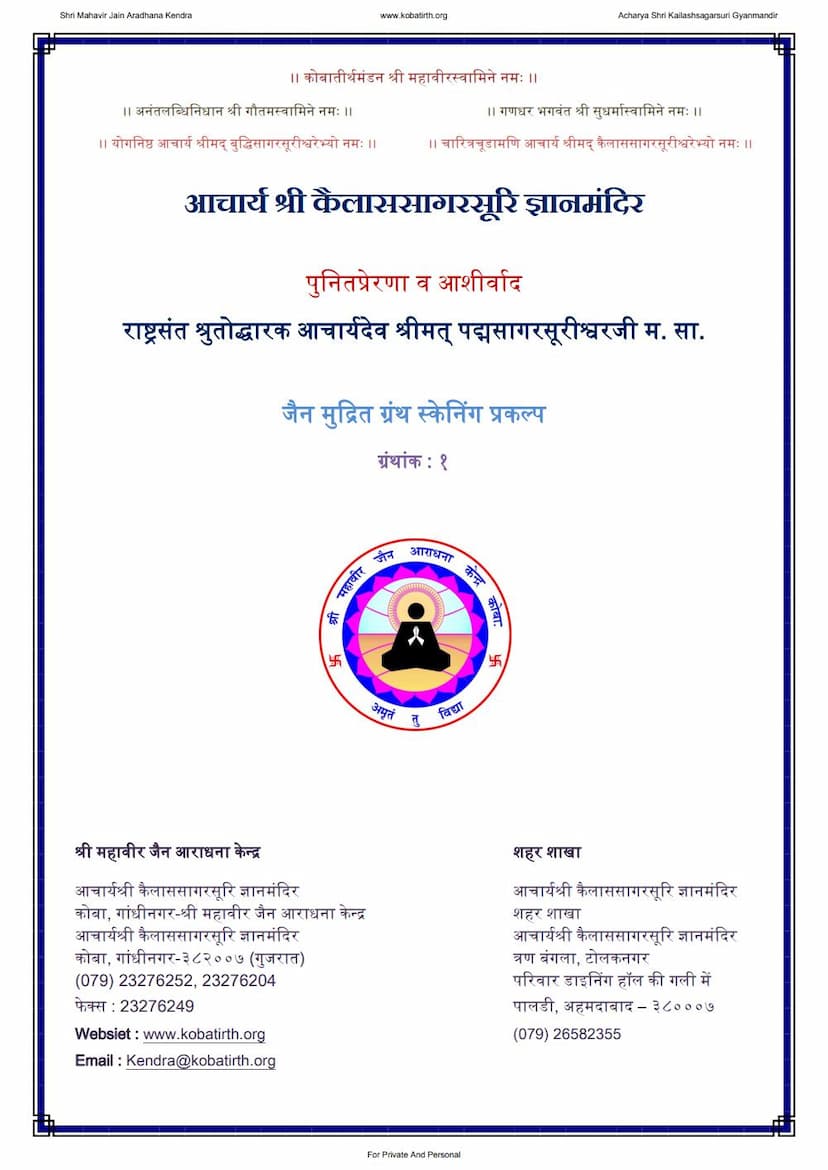Sachitra Kalpasutra
Added to library: September 2, 2025

Summary
The provided text is a detailed compilation of rules and guidelines related to daily rituals and observances within the Jain tradition, seemingly extracted from a larger work titled "Achara Ratna" (Jewel of Conduct). While the initial title mentions "Sachitra Kalpasutra," the content heavily leans towards general conduct rather than the specific rituals of the Kalpasutra. The author is identified as Shreyansvijay, and the publisher as Jain Sangh.
The text delves into various aspects of a Jain layperson's life, meticulously outlining prescribed actions, prohibitions, and their underlying principles. Here's a breakdown of the key themes and topics covered:
I. General Principles and Definitions (Paribhasha):
- Purity and Cleanliness (Shaucha): Emphasizes the paramount importance of purity, both external and internal, as the root of a twice-born (Dvija) person's life. It details the specific procedures for cleansing oneself after bodily excretions, including the types of earth to be used, the quantity, and the direction of facing.
- Aachaman (Sipping Water): Explains the ritual of sipping water for purification before performing religious duties. It specifies the correct method, the use of specific finger-tips (tirthas), and the proper order of touching different parts of the body.
- Daily Rituals (Ahnikam): Covers the importance of waking up during the Brahma Muhurta (auspicious time before sunrise) and the prescribed morning actions, including salutations and remembering deities.
- Bathing (Snanam): Details various types of baths (nitya - daily, naimittika - occasional, kamya - desired), their specific timings, the purity of water sources (rivers, wells, tanks), and the materials to be used for cleansing the body. It also touches upon specific rules for bathing during different periods and for different individuals.
- Tilak/Urdhvapundra (Applying Marks): Explains the significance and method of applying sacred marks on the forehead and other parts of the body, often associated with specific deities and their mantras. It discusses the materials to be used (earth from sacred places, sandalwood, ash) and their specific properties.
- Sandhya (Daily Prayers): Describes the timing and procedures for performing the Sandhya rituals, which are considered essential daily observances. This includes the importance of chanting Gayatri Mantra and other prayers.
- Worship of Deities (Deva Puja): Outlines the rules for worshipping deities, including the selection of appropriate places, materials (vessels, flowers, incense, lamps, offerings), the process of invocation (avahana), worship itself (puja), and the conclusion (visarjana). It discusses the significance of different types of flowers and incense for various deities.
- Homam (Fire Sacrifice): Details the procedures for performing fire sacrifices, including the preparation of the altar, the fire, the offerings, and the specific mantras to be used. It discusses the importance of maintaining the sacred fire and the procedures in case of its disturbance.
- Baliharana (Offerings to Elements/Beings): Explains the ritual of making offerings to various elements and beings, including directions for offerings to deities, ancestors, spirits, and even animals.
- Pitru Yajna (Worship of Ancestors): Focuses on the rituals for honoring ancestors, including the timing, materials, and procedures for offering water and food. It discusses the differences in rituals for different lineage members and the importance of performing these rites correctly.
- Food Observances (Bhojanam): Provides extensive rules regarding what to eat and what to avoid, the proper method of eating, the etiquette during meals, the purity of food and vessels, and the purification rituals to be performed in case of contamination. It also touches upon fasting and specific dietary restrictions on certain days.
- Post-Meal Rituals: Covers the actions to be performed after finishing a meal, including sipping water (apośana), cleaning the hands and mouth, and the significance of these actions.
- General Conduct: Interspersed throughout the text are rules of conduct concerning behavior, cleanliness, and adherence to prescribed rituals to maintain spiritual purity.
II. Specific Rituals and Regulations:
- Sacred Thread (Yajnopavita): Mentions rules related to the sacred thread, its proper wearing, and procedures in case of its loss or contamination.
- Hair Tuft (Śikhābandha): Discusses rules related to maintaining a hair tuft, including its binding and its significance during rituals.
- Clothing: Provides guidelines on wearing appropriate clothing for different rituals and times, including the types of fabrics and colors.
- Posture and Direction: Specifies the correct postures and directions to face during various rituals and prayers.
- Silence (Mouna): Mentions periods when silence is prescribed.
- Prohibitions: Lists numerous prohibitions to maintain purity and avoid spiritual impurity.
- Penances (Prāyaścitta): Briefly alludes to penances for transgressing certain rules.
Overall Impression: The text appears to be a very comprehensive manual for everyday Jain religious practice, likely intended for individuals seeking to understand and follow the prescribed conduct meticulously. It draws from a variety of sources, citing various ancient texts and authorities (like Manu, Yājñavalkya, Vasiṣṭha, Atri, etc.) to establish the validity of its guidelines. The level of detail is extensive, covering minute aspects of each ritual.
The provided text snippet focuses heavily on the "Achara Ratna" aspect, elaborating on daily observances, purity laws, and worship rituals, which are fundamental to the practice of Jainism. The mention of "Sachitra Kalpasutra" in the title might suggest that this "Achara Ratna" serves as a guide to understanding and enacting the practices described in the Kalpasutra, or perhaps it's an introduction to the broader principles before delving into the more specific and complex rituals of the Kalpasutra.
The content is highly technical and specific to Jain ritualistic practices. It emphasizes a disciplined and ritualistically pure lifestyle as a means of spiritual progress.